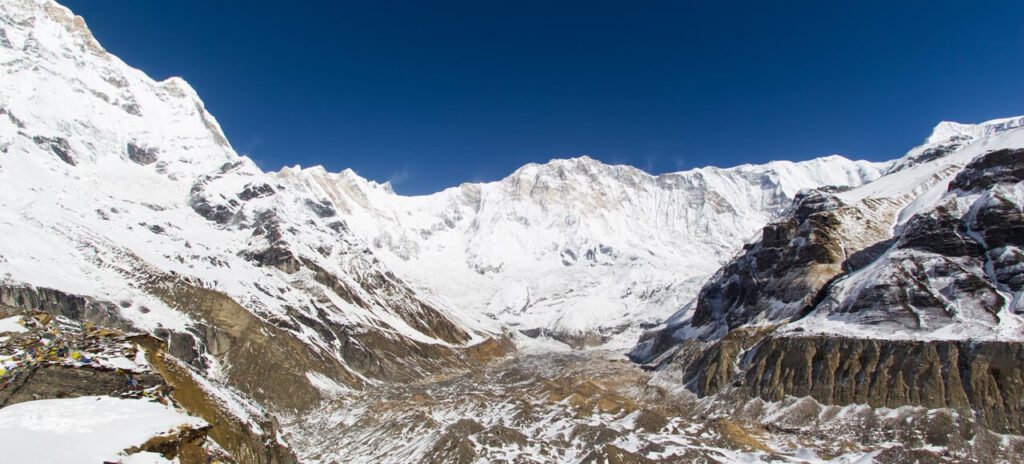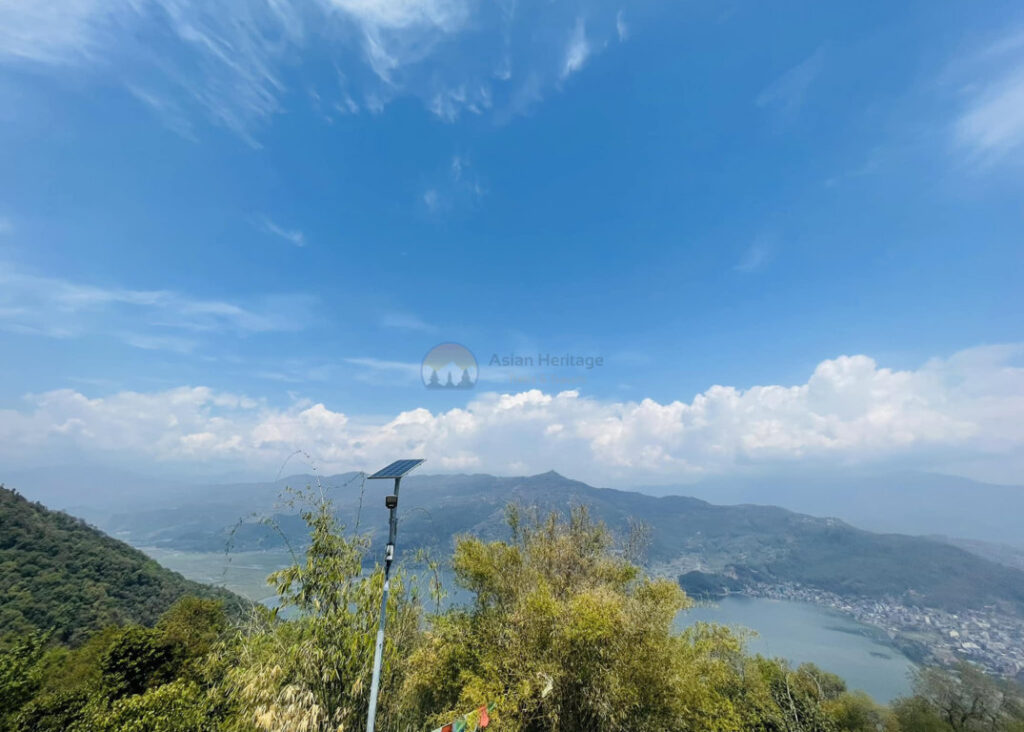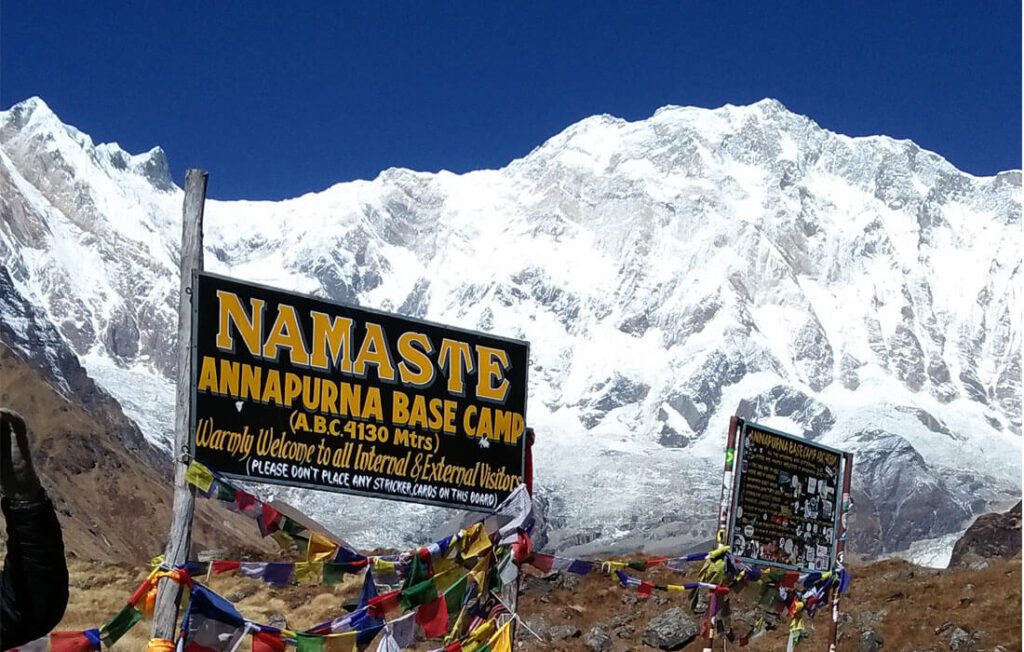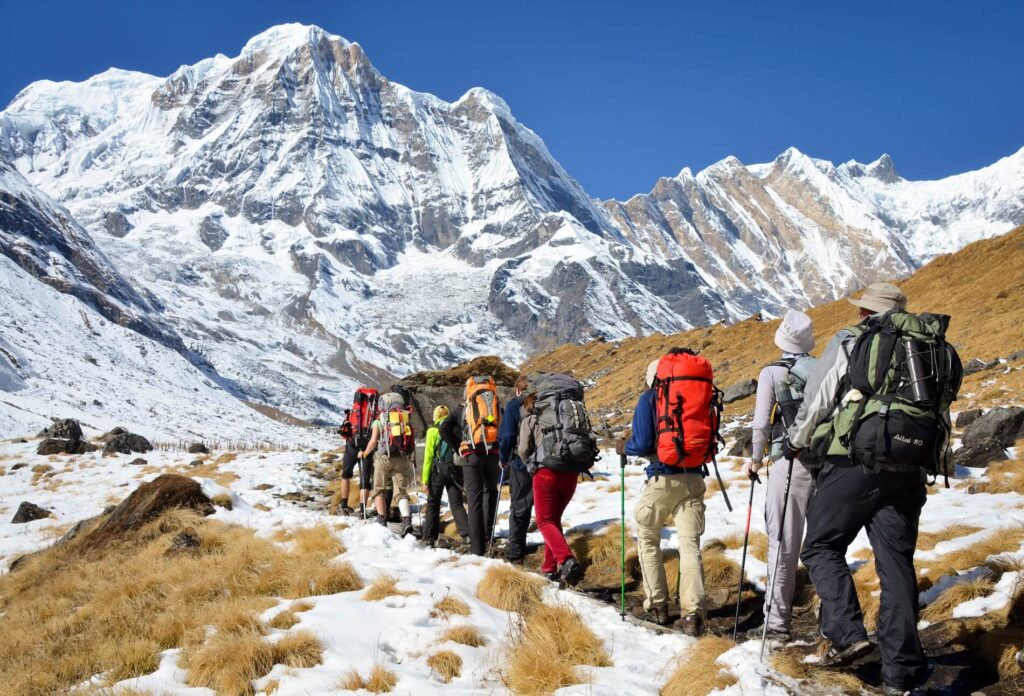Annapurna Base Camp Trek in June – Are you ready for an unforgettable adventure? Imagine trekking through lush green forests, crossing suspension bridges, and gazing up at the stunning Annapurna mountain range shrouded in mist and clouds. That’s what you can expect when trekking to Annapurna Base Camp in June!
Yes, the monsoon season may bring occasional rain and thunderstorms, but that only adds to the excitement and adventure of the trek. You’ll hike through lush forests filled with vibrant flora and fauna and cross over thrilling suspension bridges with breathtaking views. But the real highlight of the trek is the Annapurna mountain range. You’ll be awed by the sight of towering peaks like Annapurna I, Hiunchuli, and Machhapuchhre (also known as Fishtail) rising majestically into the clouds. You’ll finally reach the Annapurna Base Camp and be rewarded with a panoramic view of the surrounding mountains. It’s a truly unforgettable experience that you won’t want to miss!
So, pack your bags, put on your hiking boots, and get ready for an adventure of an Annapurna Base Camp Trek in June!
Location and Altitude
The Annapurna Base Camp is located in the Annapurna Conservation Area of the Himalayas in central Nepal. It lies at an altitude of 4,130 meters (13,550 feet) above sea level. The ABC is situated at the foot of the Annapurna massif with an elevation of 8,091 meters (26,545 feet).
The weather at Annapurna Base Camp Trek in June
The weather at Annapurna Base Camp Trek in June is generally warm and humid with occasional rainfall. The average temperature during the daytime can range from 10°C to 20°C (50°F to 68°F) while the nighttime temperature can drop to around 0°C to 5°C (32°F to 41°F).

June falls during the monsoon season in Nepal, so it’s likely that you will experience some rainfall during your visit. The amount and frequency of rainfall can vary but you should be prepared for the possibility of heavy rainfall and thunderstorms. The trails can be slippery and muddy, so it’s important to have appropriate footwear and clothing.
Despite the wet conditions, June can still be a good time to visit Annapurna Base Camp as the surrounding landscape is lush and green, and the crowds are usually smaller compared to the peak trekking season in October and November.
The crowd in Annapurna Base Camp Trek in June
Annapurna Base Camp is a popular trekking destination in Nepal, and June falls during the monsoon season in the region. During this time, the weather can be unpredictable with frequent rain showers and cloudy conditions.
Also Read: Annapurna Base Camp Trek in May
Generally, the number of trekkers to Annapurna Base Camp during June is lower than during peak seasons like spring and autumn. However, it’s hard to predict exactly how crowded it will be as it can depend on various factors like weather conditions, travel restrictions, and individual trekker preferences.
If you’re planning to do Annapurna Base Camp Trek in June, you should still expect some level of crowds on the trail especially around popular resting points and tea houses.
Route of Annapurna Base Camp Trek in June
The trek starts with a scenic drive or a flight from Kathmandu to Pokhara which is a popular tourist destination and the gateway to the Annapurna region. Pokhara is a vibrant city known for its stunning lake, scenic views of the Himalayas, and adventure activities like paragliding and zip-lining.

From Pokhara, you will take a drive to Nayapul which is the starting point of the trek. The first day of trekking takes you to Tikhedhunga through lush rice paddies and traditional villages. The trail is well-marked and you will come across several suspension bridges and small streams along the way. Tikhedhunga is a small village with a few teahouses and lodges where you can rest and recharge.
The next day, you will ascend a winding stairway to reach Ulleri, a village renowned for its breathtaking views of the surrounding mountains. After leaving Ulleri, the path continues through extensive rhododendron woods until it reaches Ghorepani, a well-liked rest station on the Annapurna Base Camp Trek. At a height of 2,874 meters, Ghorepani provides breathtaking views of the Dhaulagiri and Annapurna mountains.
Poon Hill to Base Camp
On day 5, you will wake up early and hike up to Poon Hill for a panoramic view of the surrounding mountains including Mt. Machhapuchhre. Poon Hill is one of the highlights of the trek and the views from the top are simply breathtaking. After descending from Poon Hill, you will trek to Tadapani which is a small village located at an altitude of 2,630 meters.

The trek then takes you to the picturesque village of Chhomrong on day 6, followed by Dovan on day 7. Chhomrong is located on a ridge above the Modi Khola River, and it offers stunning views of the Annapurna South and Hiunchuli peaks. Dovan is a small village located at an altitude of 2,500 meters surrounded by lush forests and small streams.
By the eighth day, your trek will lead you to Machhapuchhre Base Camp, nestled at an elevation of 3,700 meters. En route to the Base Camp which is situated in a natural amphitheater encircled by towering peaks, you’ll traverse lush forests and cross several streams. The following day, you’ll reach the splendid Annapurna Base Camp at an altitude of 4,130 meters. From this vantage point, you’ll be surrounded by the Annapurna massif and other majestic mountains offering awe-inspiring views.
Highlights of Annapurna Base Camp in June
June is a great time to visit the Annapurna Base Camp as it is the beginning of the monsoon season which means there is less trekker traffic and the landscape is lush and green. Here are some highlights of Annapurna Base Camp in June:
The trek offers several highlights of the surrounding mountains that can be seen from the base camp. One of the most prominent peaks visible from the camp is Annapurna South, standing tall at 7,219 meters. Hiunchuli, at 6,441 meters is another stunning sight with its steep snow-covered slopes. The “Fishtail” Mountain also known as Machhapuchhre is one of the renowned peaks in the region, with its distinct shape visible from the entire trail. Annapurna I, towering at 8,091 meters, the highest peak in the range, is visible from various points along the trek. From the Annapurna Base Camp Trek, one can catch a glimpse of the snow-capped peak of Dhaulagiri, which ranks as the seventh-highest mountain on the planet with a towering height of 8,167 meters (26,795 feet). The stunning view of this majestic peak from the base camp adds to the already magnificent surroundings of the trek.
You may also like: Annapurna Base Camp Trek in April
At the onset of the monsoon season, the most notable feature of the region is its abundant vegetation. The terrain is enveloped in greenery which breathes new life into the surroundings and brings vibrant colors to the hills and forests. This lush landscape offers a delightful contrast to the barren desert terrain that dominates during other seasons.
Fewer Crowds and Clear View
Another benefit of visiting Annapurna Base Camp in June is that there are fewer crowds. The trek is a popular destination, and during peak season, it can become quite busy. However, in June, the number of trekkers is relatively low making for a more peaceful and serene trek. With fewer people on the trails, you can enjoy the stunning scenery and the natural beauty of the region without the crowds.

The third highlight is the clear views of the Annapurna and Dhaulagiri mountain ranges. The early days of June offer great visibility with clear skies, allowing trekkers to enjoy unobstructed views of the towering peaks. As the day progresses, clouds start to form, creating dramatic and awe-inspiring scenery. The changing weather patterns provide a unique and ever-changing backdrop to your trek.
One of the most spectacular highlights of the June Annapurna Base Camp excursion is the abundance of waterfalls that adorn the trails. As the rainy season commences, the paths are adorned with stunning cascading waterfalls offering a refreshing escape from the challenging hike. Not only do these waterfalls provide a serene and beautiful ambiance but they also offer a much-needed respite from the demanding trek.
Local Culture and Diverse Wildlife
The traditional villages that you pass through en route to the base camp constitute the fifth notable aspect of the journey. These communities including Chomrong, Bamboo, and Deurali offer a window into the unique customs and way of life of the locals. It’s possible to engage in conversations with the locals, sample their cuisine and learn more about their culture.

The Annapurna region is home to diverse wildlife, and June is an excellent time for wildlife sightings. You may spot some rare species of birds, including Himalayan Monal, Koklass, and Pheasants, and if you are lucky you may even spot some Himalayan Tahrs, Langurs, and Musk Deer. The wildlife sightings add an element of excitement and wonder to the trek, and they provide a unique and unforgettable experience.
Festival in June
Ropain Festival
Ropain Festival, also known as Rice Plantation Festival is a traditional festival in Nepal that celebrates the beginning of the rice planting season. It is usually celebrated in the month of June or July, which is the time when the monsoon season starts and the farmers begin to plant rice in their fields.
Popular: Annapurna Base Camp Trek in February
The festival is celebrated with great zeal and enthusiasm all over Nepal, especially in rural areas where farming is a way of life. The festival is marked by various cultural activities such as singing traditional songs performing traditional dances like Deuda and feasting. This also provides an opportunity for farmers to socialize and share their experiences with each other.
The Ropain Festival holds a significant place in Nepalese history and culture, highlighting the importance of agriculture and specifically, rice farming. Along with celebrating the harvest season, the festival provides an opportunity for Nepalese people to come together, express their gratitude to the deities, and revel in joy.
Merits and Demerits
Trekking to Annapurna Base Camp in June has its own merits and demerits. Some of them are:
Merits
- Fewer Crowd: As June is considered an off-season for trekking in Nepal, you can expect to see fewer tourists on the trail. This can be a plus for those who want to enjoy the beauty of the trek without having to navigate through large crowds. You can also get better rates for accommodation and food as fewer tourists mean lower demand for these services.
- Lush Greenery: During the monsoon season, the Annapurna region receives heavy rainfall which makes the surroundings incredibly lush and green. The fields and forests are blooming with colorful flowers and vegetation and the scenery is simply breathtaking. The monsoon season is also the time when the rivers and streams are in full flow which makes for some spectacular views along the way.
- Lower Costs: As mentioned earlier, since June is an off-season for trekking you can expect to find lower prices for accommodation and transportation. This can be a plus for budget travelers who want to experience the beauty of the Annapurna region without breaking the bank.
Demerits
- Monsoon Season: June is the beginning of the monsoon season in Nepal which means that you can expect heavy rainfall and muddy trails. This can make trekking more challenging and difficult, and you’ll need to be prepared with proper trekking gear, including raincoats, waterproof hiking boots, and backpack covers.
- High Humidity: Hiking in the rainy season can be more challenging due to the elevated levels of humidity making the journey seem more arduous. The atmosphere may feel thick and moist causing discomfort and perspiration. It’s crucial to stay hydrated and take frequent breaks to prevent heat exhaustion.
- Limited Visibility: Due to the monsoon season, the mountain views may be obscured by clouds and mist. This can be disappointing for those who are hoping to see the panoramic views of the Annapurna mountain range. However, if you’re lucky, you may catch a glimpse of the mountains when the clouds clear and the scenery is nothing short of spectacular.
Tips for Annapurna Base Camp in June
If you plan to hike in June, there are a few crucial factors to take into account. The weather during this time of year is generally humid and rainy, so it’s crucial to pack lightweight, fast-drying clothes, a raincoat, waterproof pants, and durable hiking boots. Additionally, mosquito repellent is a must-have since the monsoon season is when bugs and mosquitoes are most active.

Starting your trek early in the morning is recommended as the weather is generally clear during this time. Staying hydrated is important, so make sure to bring a water bottle or hydration pack and drink at least 2-3 liters of water per day. The Annapurna Base Camp Trek is challenging, so it’s important to pace yourself and take breaks when needed. Hiring a local guide is also recommended, as they can help you navigate the trail, provide cultural and historical information and ensure your safety.
More: Annapurna Base Camp in January
Bringing enough cash is essential as there are few ATMs on the trek. You’ll need to pay for food, accommodation, and other necessities along the way. You’ll also need to obtain a trekking permit to enter the Annapurna Conservation Area which can be obtained from the Nepal Tourism Board or a local trekking agency.
Altitude sickness is a potential issue as the Annapurna Base Camp Trek reaches an altitude of over 4,000 meters. To avoid altitude sickness acclimatize properly, drink plenty of water, and take precautions such as Diamox if necessary. Finally, it’s important to respect the local culture, dress modestly, ask permission before taking photos of people, and be mindful of your actions.
Let our expert team at Asian Heritage Treks and Travel take care of everything — from guided tours to personalized packing tips and travel arrangements.
Plan My Annapurna Trip







